monotype: the painterly print
"I like the excitement...that you don't really know how a piece will turn out until you pull the paper off the plate...and that lack of control...that spontaneity and surprise---is what really excites me about the monotype process. The best work I do is that which is organic, that flows, and has a rhythm. It's not like I plan the colors from the very beginning...as you paint, you determine what a painting needs."
What is a Monotype?
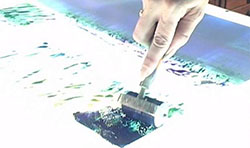 The process is really the simplest form of printmaking, in a way, because the artist does not etch or carve into a plate. Instead, a monotype is created by first painting onto a flat surface (in Margaret's case, a plexi-glass plate), and this wet painting is then pressed to paper. Much planning is done prior to studio work, as the composition needs to come together quickly (the inks must be wet so that they will transfer properly).
The process is really the simplest form of printmaking, in a way, because the artist does not etch or carve into a plate. Instead, a monotype is created by first painting onto a flat surface (in Margaret's case, a plexi-glass plate), and this wet painting is then pressed to paper. Much planning is done prior to studio work, as the composition needs to come together quickly (the inks must be wet so that they will transfer properly).
Most of Margaret's monotypes are mixed-media...they often involve not only the oil-based printing inks, but watercolors and sometimes gouache (a water-based opaque paint) as well. However, in order to add water-based paint, there must be areas where the paper is exposed, for as you know, the oil-based inks repel these other media. Below are photographs of the process that may help you understand better the work that goes into a monotype...However, the most important message we try to impart upon our clients is that a monotype is just as original and unique as a painting. A mono-type is "one-impression." It is not in any way a reproduction or part of a series.
The Monotype Process
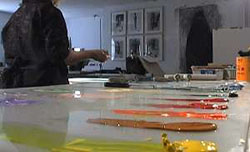
The print studio is out in Margaret's country home in Meggett, SC. Before starting, Margaret gets all her plates and paper, inks and brushes ready. Photos, ideas, surround the workspace...
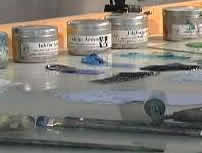
The work is usually fast-paced, spontaneous, intuition-driven...The inks blend together over the course of the day, and thus each day brings a completely new and unique palette of colors...

Margaret has many different plates, all different sizes. The plate is on a light table and is backlit...this helps clarify which areas need work and shows more specifically where the exposed areas of paper will be.
"The best work I do is that which is organic, that flows, and has a rhythm...It's not like I plan the colors from the very beginning...as you paint, you determine what a painting needs."
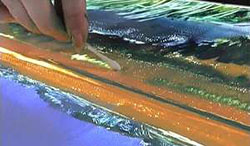
After applying ink to the plate, Margaret then lifts ink from the composition, creating areas of sharp negative space.
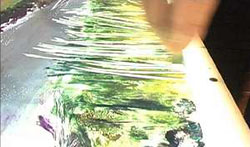
These areas become the only spaces where watercolor and other water-based media can be added.
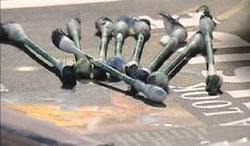
Margaret uses q-tips, pieces of matte board, and her fingers to remove ink from the plate.
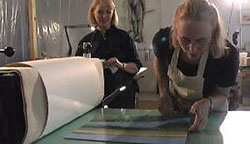
Margaret then brings the plate to the press, making sure the paper and the plate are aligned properly...
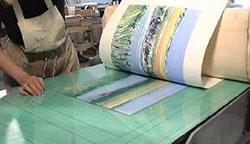
600 pounds of pressure are applied so that as much ink as possible is transferred to the paper...the emerging monotype is a reverse image of what I've painted.
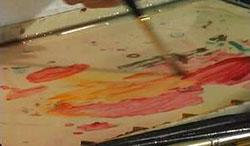
Before adding watercolor to the monotypes, I usually wait a few days...I can't rush with it. I have to let things "marinate" for a while.I bring the new monotypes back to the gallery, and eventually begin to add
the bright, soft watercolors.
"When you work with watercolors, every single move you make is irreversible: every drop of paint is there to stay, so as a result, the nature of this step is way more deliberate...nearly the opposite of the spontaneous printmaking work. The inks in the print studio set the design...the watercolors provide the highlights, the fine tuning. When you look at one of these monotypes, it is actually the watercolors that come forward visually..."
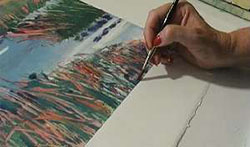
The exposed areas of watercolor paper easily soak up paint from the brush, while the oil
based ink repels it.
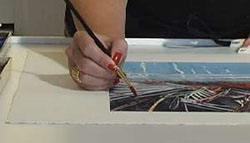
Margaret often contrasts bright, warm watercolors with the deeper, cooler tones of the inks...and visually, these bright tones leap forward, giving her monotypes an interesting and exciting charged energy.
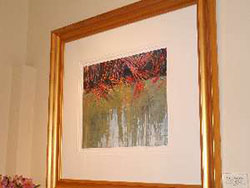
Because they are works on paper, Monotypes need to be framed under glass. The gallery recommends museum quality glass, which minimizes glare and protects the piece from harmful sunlight.
"For monotypes, I usually choose organic subjects...when I'm working with natural subject matter, I don't have to plan as much...I can work more from my heart...Since I've lived in the coastal wetlands of South Carolina my whole life, it is what I know...it's just in my blood." -- Margaret Petterson